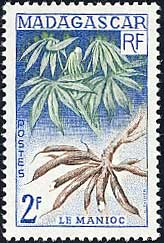Cassava
|
|
| Cassava | ||||||||||||||
|---|---|---|---|---|---|---|---|---|---|---|---|---|---|---|
 Manihot esculenta | ||||||||||||||
| Scientific classification | ||||||||||||||
|
Cassava or manioc (Manihot esculenta; also yuca in Spanish, and mandioca, aipim, or macaxeira in Portuguese) is a woody perennial shrub of the spurge family, that is extensively cultivated as an annual crop for its edible starchy tuberous root. It was originally observed in what are now called Brazil and Paraguay, and today is widely diffused in tropical and subtropical regions, and may be called the "potato of the tropics". All known species and varieties are cultigens.
World production of cassava root was estimated to be 184 million tonnes in 2002, the majority of production is in Africa where 99.1 million tonnes were grown, 51.5 million tonnes were grown in Asia and 33.2 Mt in Latin America and the Caribbean.
| Contents |
Description
The root is long and tapered, with a firm homogeneous flesh encased in a detachable rind, about 1 mm thick, rough and brown on the outside. Commercial varieties can be 5 to 10 cm in diameter at the top, and 50 to 80 cm long. A woody cordon runs along the root's axis. The flesh can be chalk-white or yellowish; it breaks like a carrot's, and darkens quickly upon exposure to the air. (For this reason, the skinned root must be kept under water until it is ready to be cooked.) Even under refrigeration, the root's flavor spoils in a day or so, and therefore it is not very popular with supermarkets.
The root contains free and bound cyanogenic glucosides which are converted to HCN in the presence of linamarase, a naturally occurring enzyme in cassava. In the past, cassava was categorized as either sweet or bitter, signifying the absence or presence of toxic levels of cyanogenic glucosides. The so-called "sweet" (actually "not bitter") cultivars can produce as little as 20 mg of HCN per kg of fresh roots, while "bitter" ones may produce more than 50 times as much (1 g/kg). Bitter varieties must be processed so as to remove the cyanogenic glucosides.
Uses
The root is usually cooked into a great variety of dishes. If eaten raw, the root is poisonous and can be fatal, because the digestive process produces cyanide within the body. The soft-boiled root has a delicate flavor and can replace boiled potatoes in many uses: as an accompaniment for meat dishes, or deep-fried, made into pur�es, dumplings and gnocchi, soups, stews, gravies, etc. Cassava flour can also replace wheat flour, and is so-used by some people with allergies to other grain crops. Tapioca and foufou are made from the starchy flour from cassava root.
In West Africa, particularly in Nigeria, cassava is commonly prepared as Eba or Gari. The cassava is grated and fried then mixed with boiling water to form a thick paste.
Cassava is heavily featured in the cuisine of Brazil. The dish vaca atolada ("mud-stranded cow") is a meat and cassava stew, cooked until the root has turned into a paste; and pir�o is a thick gravy-like gruel prepared by cooking fish bits (such as heads and bones) with cassava flour. In the guise of farofa (lightly roasted flour), cassava combines with rice and beans to make the basic meal of lower class Brazilians. Farofa is also a standard side dish for feijoada, the famous meat-and-beans stew. Boiled cassava is also made into a popular sweet pudding. Deep-fried mandioca is a popular snack.
Cassava was, and still is, a major staple food for many native tribes of tropical South America, since pre-Colombian times. It was grated into flour and made into pancakes; bitter varieties were detoxified by washing the flour. Fermentation of cassava gruel produced cauim, a mild alcoholic beverage consumed in vast quantities by natives at parties and ceremonies.
Cassava is used as animal feed in Latin America and the Caribbean, China, Nigeria and the EU.
Cassava pests
In Africa the cassava mealybug (Phenacocus manihoti) and cassava green mite (Monoychellus tanajoa) can cause up to 80% crop loss, which is extremely detrimental to the production of subsistence farmers. These pests were rampant in the 1970s and 1980s but were brought under contol following the establishment of the Biological Control Centre for Africa. The Centre investigated biological control for cassava pests and two South American insects Epidinicarsis lopezi and Typhlodromalus aripo were found to effectively control the cassava mealybug and the cassava green mite respectively.
